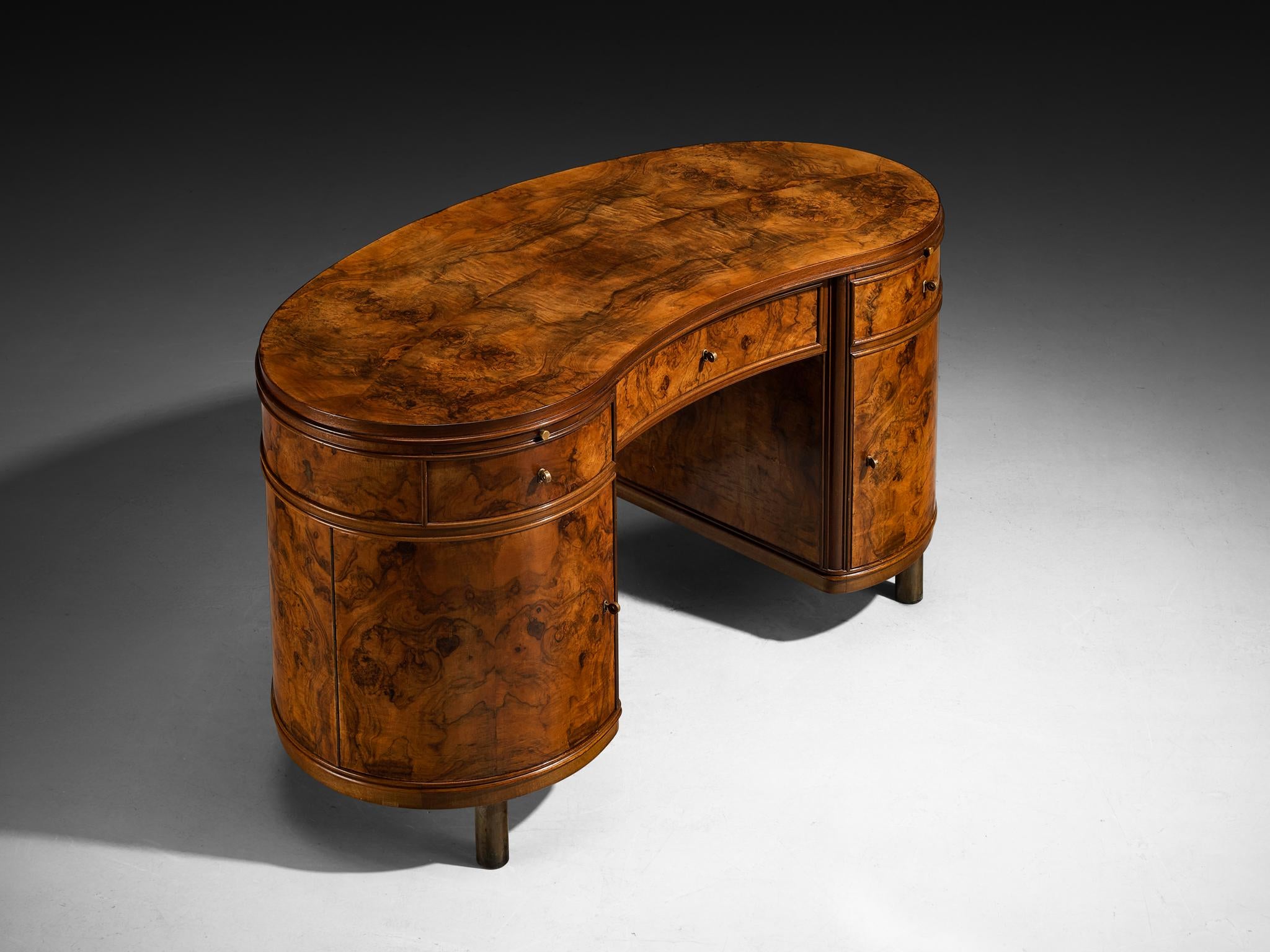
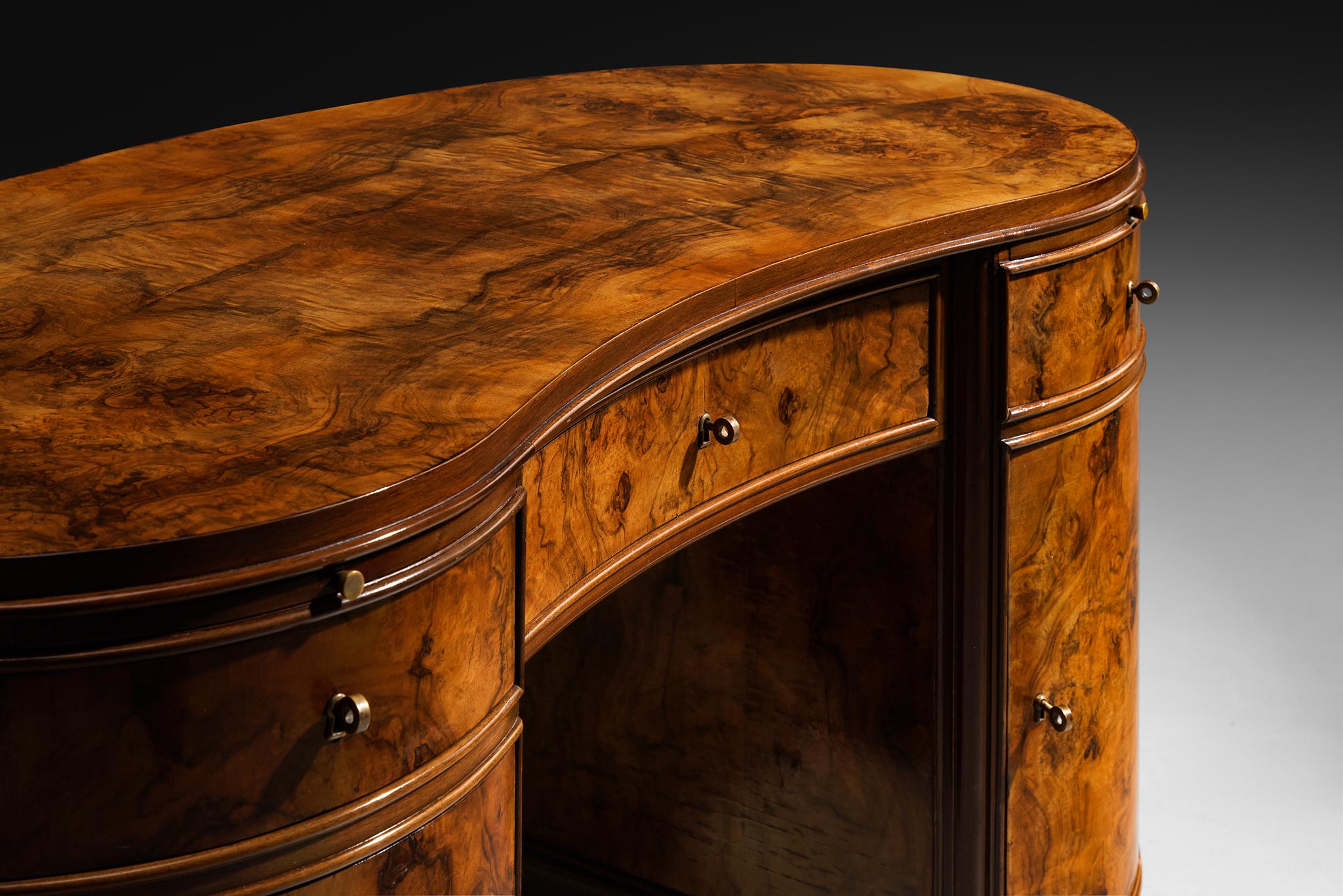
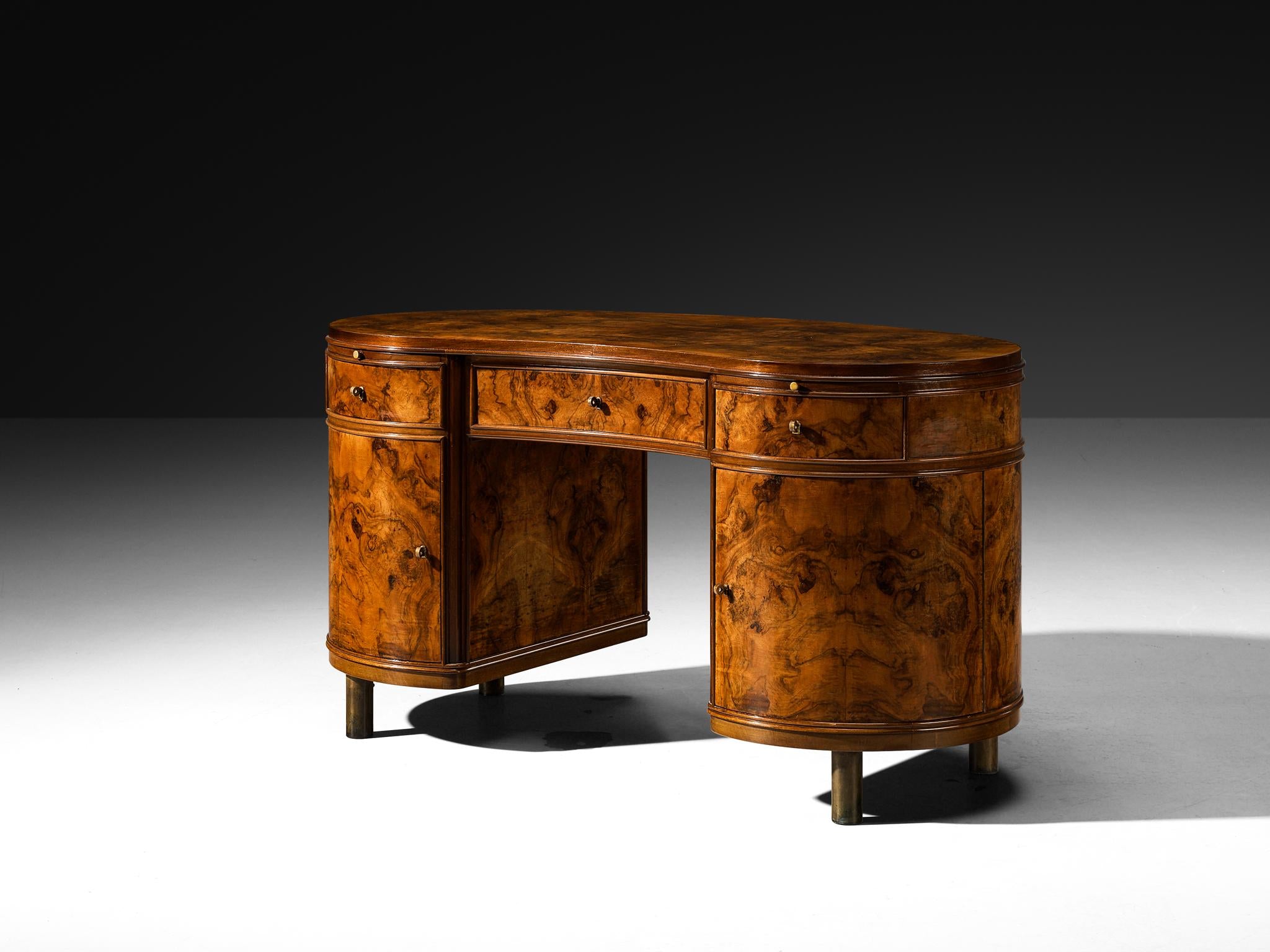
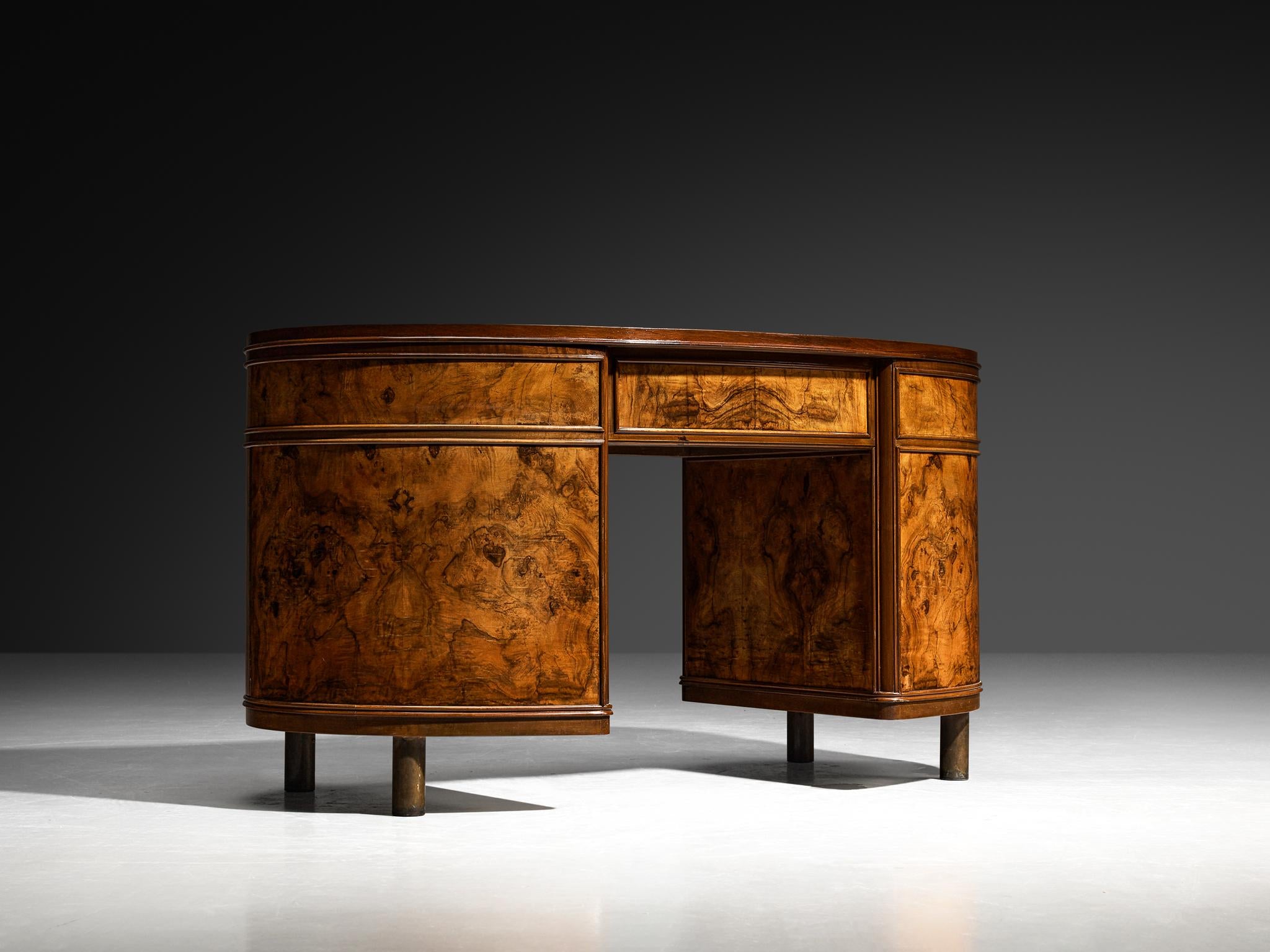
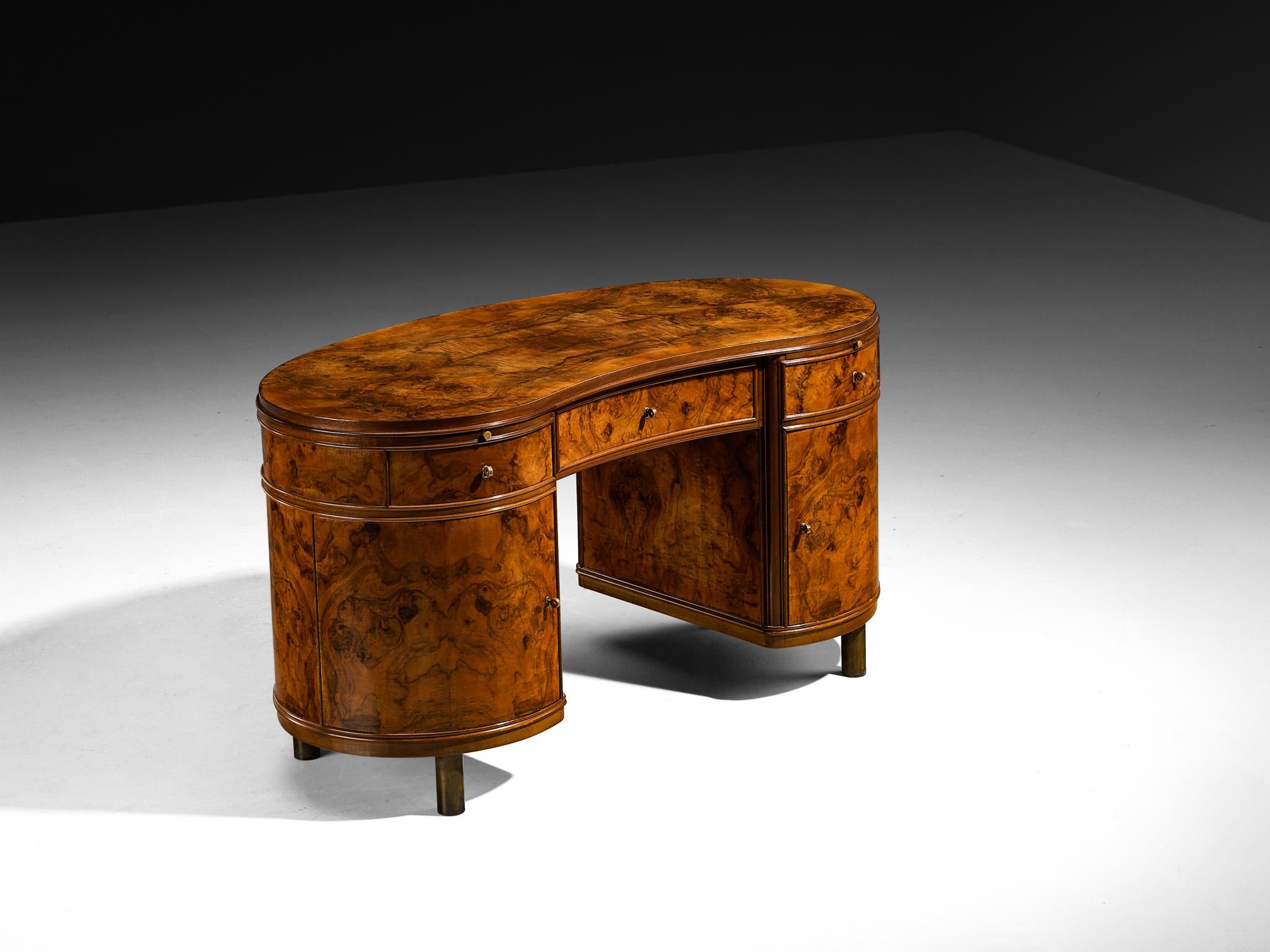
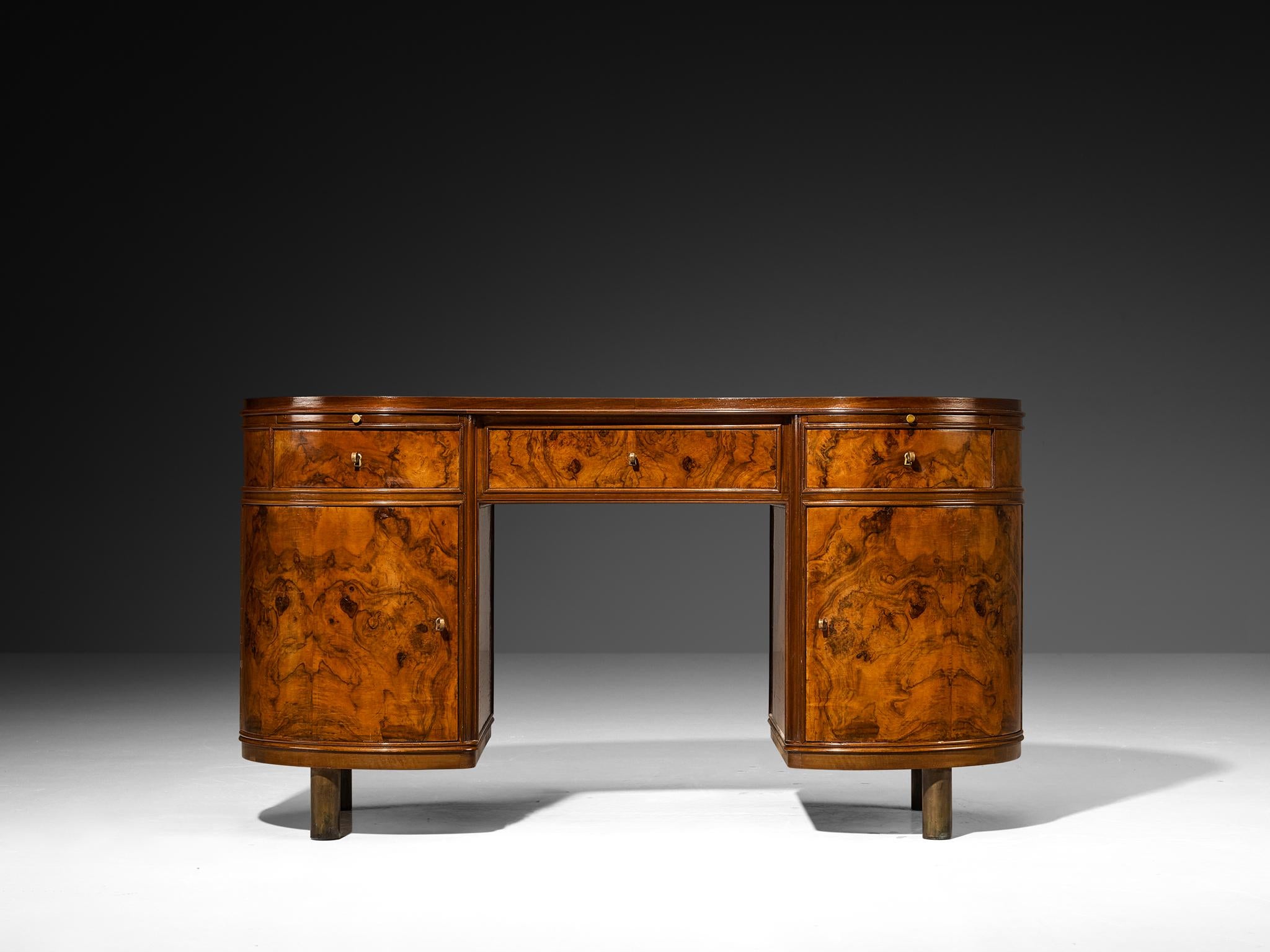
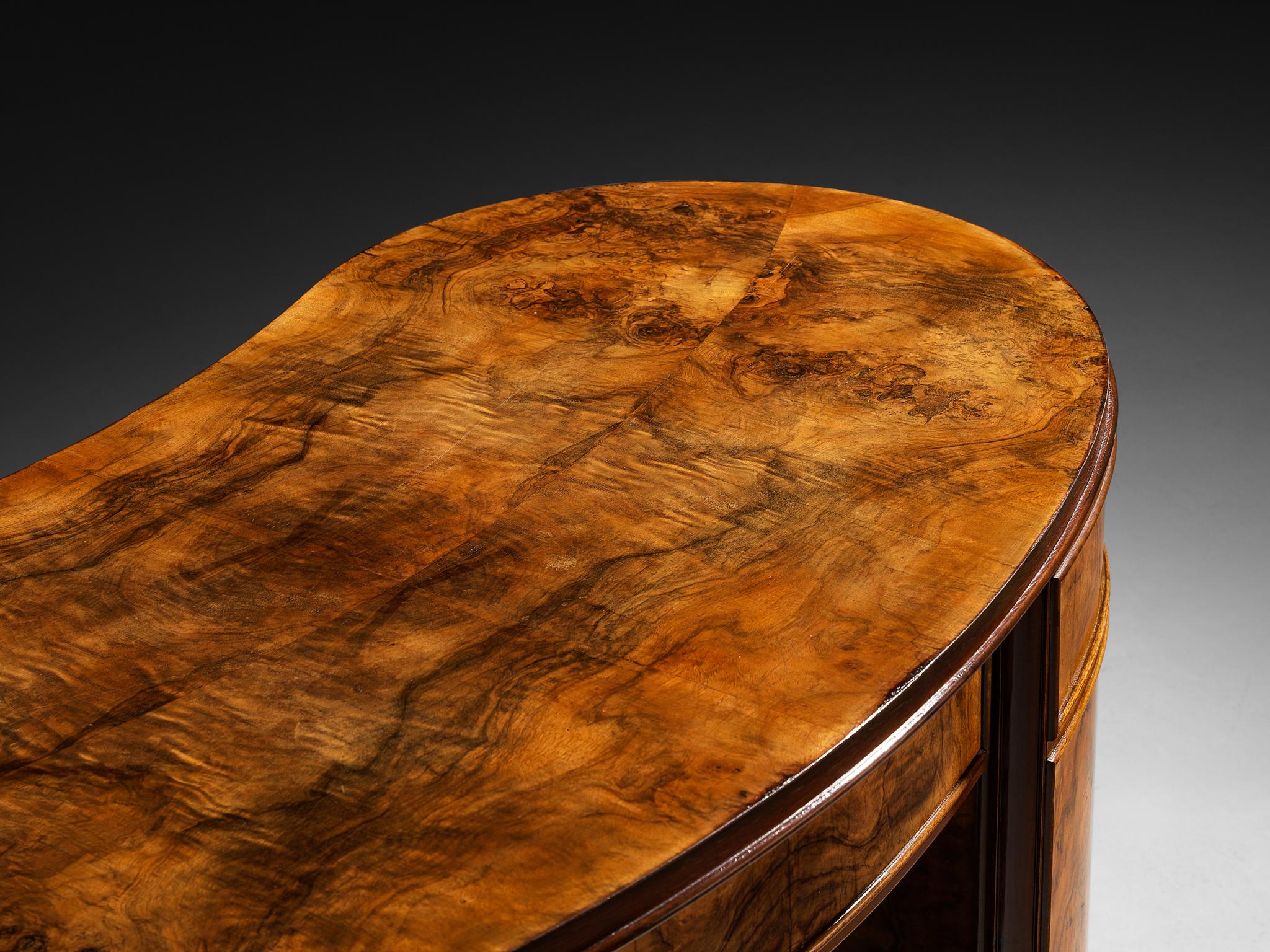
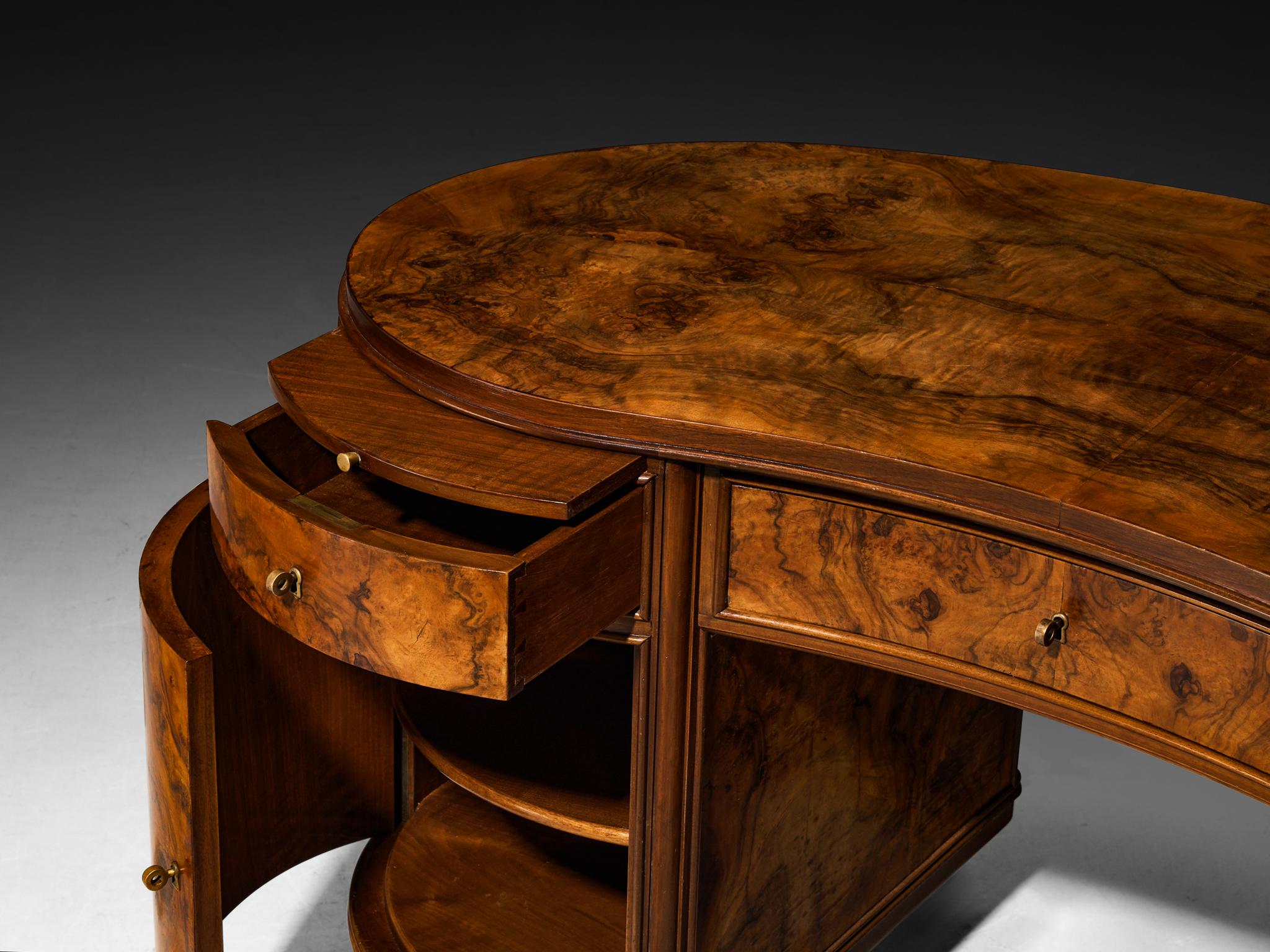
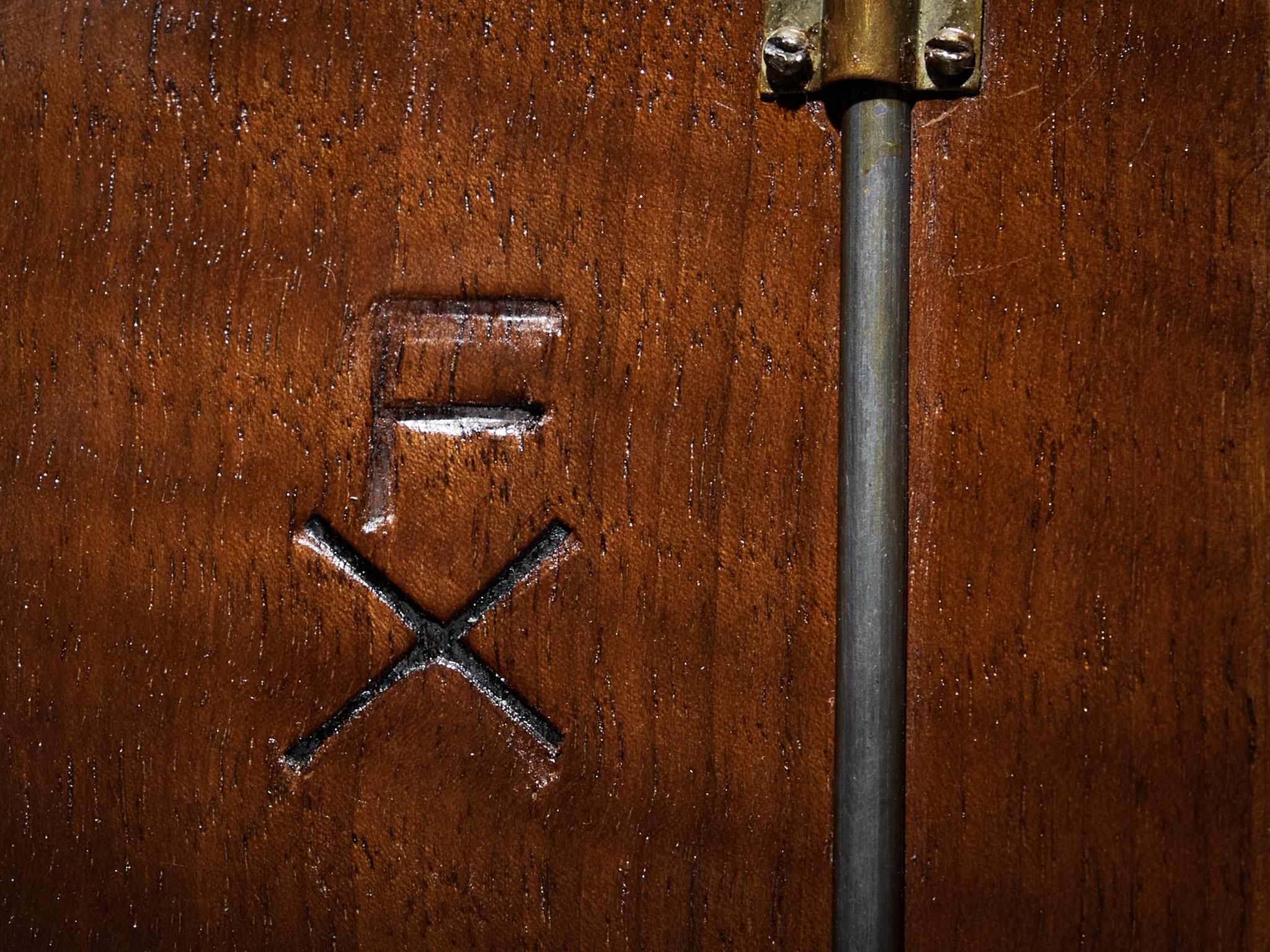
Fontana Arte Free-Standing Writing Desk in Walnut Burl and Brass
Fontana Arte, desk, walnut burl veneer, walnut veneer, brass, Italy, circa 1935
Fontana Arte, one of Italy’s most prestigious design firms, known for its pioneering contributions to lighting, glasswork, and furniture, created this desk during the company’s formative years, dating back to around 1935. This period was marked by the creative vision of Gio Ponti and Pietro Chiesa, initially producing unique, custom-tailored pieces with high standards of craftsmanship and artisanal qualities. The kidney-shaped design and modern cylindrical legs can be traced back to Pietro Chiesa’s contributions to Fontana Arte as early as ca. 1935. Furthermore, the pairing of walnut burl, a luxurious material used for the exterior, with metal is characteristic of this period in Fontana Arte’s creative output.
The desk's structure features a kidney-shaped construction with a symmetrical framework, creating a smooth, flowing appearance. To prevent the piece from feeling too visually heavy, the designer elevated the corpus on cylindrical legs made from brass, creating a clean, stable foundation. Known for its deep brown tones and swirling pattern, the walnut burl takes center stage with its expressive veins and rich hues, imparting the piece with an ornamental, yet natural look. The top's surface also displays a nearly mirrored symmetry, achieved by book-matching the veneer slices. Functionality does not come at the expense of elegance, as the desk incorporates a clever storage solution. The drawers and door panels are skillfully integrated into the construction without disrupting the curved lines of the desk. The wooden rims that run along the perimeter of the compartments highlight the piece's rounded contours and add a touch of sophistication. The desk includes additional pull-out shelves on both sides.
From a stylistic standpoint, Fontana Arte’s 1930s creations are defined by notable modernist elements, simplified forms, and a focus on glass (footnote). This desk, however, departs from that tradition, embracing a weightier, more antique-inspired aesthetic while subtly incorporating modernist features such as material contrast and clean-lined cylindrical legs in metal. As a result, it occupies a distinctive place within the company’s oeuvre. Its classically stylized silhouette, reminiscent of 19th-century French and English furniture, reflects a historical influence. Walnut burl wood and brass were preferred materials among Art Deco designers, such as Paolo Buffa, Tomasso Buzzi, and, needless to say, Gio Ponti and Pietro Chiesa. During this period, burlwood was seen as a high-end material, found exclusively in bourgeois homes. The cylindrical shape of the legs can be traced back to the Bauhaus movement, which emphasized the use of industrial materials and simple forms. The substantial thickness of the legs is also a characteristic of Nordic design. Modern influences are evident even in the finer details, such as the sleekly designed brass keys and knobs.
This observation suggests that the design in question is less representative of Fontana Arte's work from the 1930s. However, this does not diminish the desk's historical significance or value. Rather, it exemplifies the firm's transitional, experimental approach to design; one that is deeply rooted in historical movements while simultaneously pushing boundaries through innovative material and structural configurations. Moreover, during Fontana Arte’s formative years, guided by the artistic visions of Ponti and Chiesa, the firm primarily produced unique, bespoke pieces. The reproduction of previously established designs, both with and without modifications, increased after 1935, though it remained significantly less prevalent than in the 1960s (footnote). Thus, it remains entirely possible that this particular desk is unique. From a broader design-historical perspective, the piece reflects the prevailing trend in Italian design of that period, where designers engaged with historical precedents while demonstrating a commitment to innovation and artistic expression.
The piece bears the marking 'FX’, which represents the Fontana Arte brand logo. The signature can be found on one of the door panels.
Biography Fontana Arte (1932)
Fontana Arte played a significant role in the development of applied arts in the 20th century, not just in Italy but internationally. Through its innovative use of crystal in lighting and furniture design, the company became a leading force in the field over the course of three decades. This success was driven by a fusion of modern design principles and outstanding craftsmanship. At the heart of its evolution were three artistic directors – Gio Ponti, Pietro Chiesa, and Max Ingrand – whose leadership played a significant role in shaping Fontana Arte’s creative vision and long-lasting influence on the industry.
The origins of Fontana Arte can be traced back to 1881, when the 27-year-old Milanese Luigi Fontana (1892-1948) established Luigi Fontana & C., a glass manufacturing company in Milan. Initially, the firm specialized in plate glass and construction materials. It supplied both functional and decorative glass elements for architectural and interior design applications. In addition to selling glass sheets, the company expanded its operations to include cutting, grinding, silvering, decorating, and binding. These processes had previously been outsourced abroad, as there were no highly specialized firms in Italy at the time capable of carrying out such work. As a result, the company quickly established itself as a leading force in industrial glass production.
A pivotal moment in the company's history occurred in 1930, when Luigi Fontana formed a partnership with the esteemed architect and designer Gio Ponti (1897-1979). Recognized as a visionary in architecture, as well as in the decorative and applied arts, Ponti sought to expand the role of glass beyond its traditional utilitarian functions. Under the brand Luigi Fontana SA, the company began producing its first collections of light fixtures and furniture. In 1932, further transformation took place with the acquisition of Bottega, a small Milanese artisan workshop founded by Pietro Chiesa, primarily known for the production of artistic stained glass. This acquisition, coupled with Ponti’s artistic leadership, led to the official establishment of Fontana Arte as a design-focused subsidiary that would elevate glass to an artistic and functional medium.
The collaboration between Gio Ponti, Pietro Chiesa, and Luigi Fontana fostered an extraordinary synergy, positioning Fontana Arte as a pioneering force in avant-garde design. The company became a rare example of a design-driven enterprise where highly skilled artisans and visionary designers worked in unison to produce an extensive range of objects, including furniture, mirrors, portrait frames, decorative boxes, sculptures, and stained-glass windows. Fontana Arte distinguished itself particularly in the field of lighting design, where it seamlessly integrated rationalist principles with innovative glassworking techniques. This fusion of artistic vision and technical mastery resulted in exceptional, forward-thinking creations that redefined the aesthetic and functional possibilities of glass in modern design.
Within a decade, Fontana Arte had established itself as a global leader in the production of high-quality glass objects. However, despite its international acclaim and significant commercial success, the company's profitability was constrained by the exceptionally high costs associated with its artistic production processes.
The outbreak of World War II brought further challenges, leading to a severe disruption in manufacturing. The economic and material constraints imposed by the war resulted in a dramatic decline in glass sales, with sales coming to a near standstill.
Fontana Arte was born from the creative vision of Ponti and Chiesa, initially producing unique, one-off pieces. Their commercial success led the company to transition from artisanal to semi-industrial production while maintaining exceptional – though costly – quality standards. As the market evolved and retail stores multiplied, demand shifted toward repeatable designs, which were easier to sell than the exclusive one-offs of the past.
Following the unexpected death of Pietro Chiesa in 1948, who had served as artistic director since 1934, Fontana Arte struggled to find a suitable successor. After several unsuccessful attempts, Gio Ponti proposed the acclaimed French glassmaker and decorator Max Ingrand (1908-1969) for the role in 1954. Ingrand was an ideal choice, sharing Chiesa’s background in formal training and expertise in art glass, along with a deep appreciation for fine craftsmanship and a keen interest in all aspects of lighting design; still the driving force behind the Milan-based company.
A close examination of the first designs introduced under Ingrand’s direction reveals a clear evolution in style. While remaining faithful to Fontana Arte’s legacy, his work showcased a masterful fusion of metal and glass, along with a refined artistry that reflected the era’s emerging aesthetic trends. His innovative approach brought a fresh dynamism to the brand, marking the end of a distinct chapter in Fontana Arte’s history – one that had been largely shaped by the influences of Gio Ponti and Pietro Chiesa.
In 1967, Max Ingrand's tenure as artistic director came to an end, and Gio Ponti briefly resumed the role. However, conflicts arose when company leadership shifted its focus toward mass-market appeal, a direction Ponti saw as a betrayal of its long-standing commitment to excellence and innovation. As a result, he chose to sever all ties with the brand. Following Ingrand’s departure, Fontana Arte underwent several transformations, evolving from his signature decorative modernist aesthetic to a postmodern approach under Gae Aulenti, who became artistic director in 1979. Over the years, the company further embraced contemporary, minimalist, and high-tech innovations in both lighting and furniture. Despite these changes, the company continues to honor its legacy of glass artistry and Italian craftsmanship, solidifying its status as a global leader in luxury lighting design.
VAT within the EU: When buying or delivering an item within the EU, VAT usually applies and will be added.
Choose options









Product Details
VAT within the EU: When buying or delivering an item within the EU, VAT usually applies and will be added.